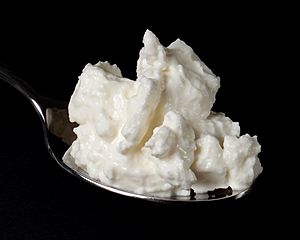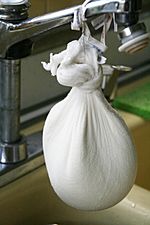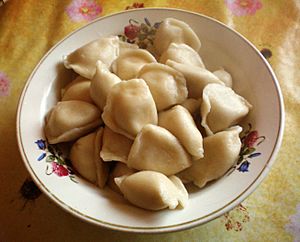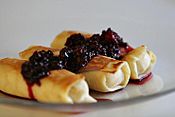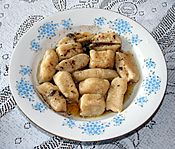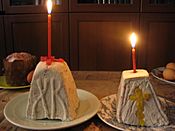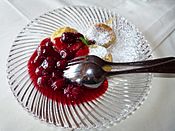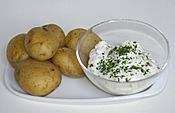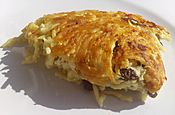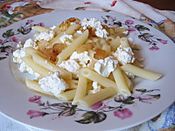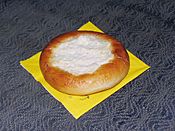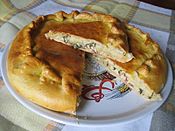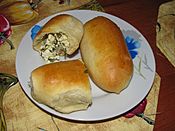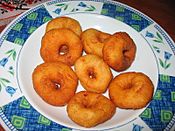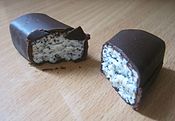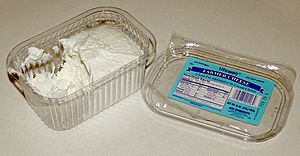Quark (dairy product) facts for kids
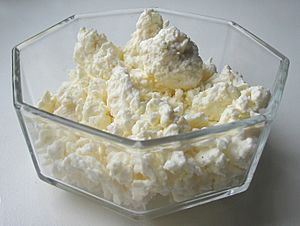
Quark (pronounced "kwark") is a fresh dairy product made from milk. It's a soft, white, and unaged food, often described as a type of fresh cheese. To make quark, milk is made sour, usually by adding special good bacteria called lactic acid bacteria. This process makes the milk thicken and form curds. After the curds form, the liquid part (called whey) is strained away.
Quark is a traditional food in countries where Germanic, Slavic, and Baltic languages are spoken. It usually doesn't have salt added. While traditional quark can be made without rennet (an enzyme that helps milk curdle), many modern dairies add a small amount.
Sometimes, people confuse quark with cottage cheese or farmer cheese. However, in places like Germany, quark and cottage cheese are seen as different kinds of fresh cheese. In Eastern Europe, cottage cheese is often considered a type of quark. For example, in Russian, cottage cheese is called "grainy quark."
Quark is similar to French fromage blanc (white cheese). It's different from Italian ricotta, which is made from heated whey. Quark is also a bit like strained yogurts such as labneh or suzma. But while those are made from yogurt (milk fermented with bacteria that like heat), quark is made from sour milk fermented with bacteria that prefer cooler temperatures.
Contents
What's in a Name?
The word Quark has been used in German since the 14th century. It likely comes from West Slavic words like Polish twaróg or Russian tvorog. These words are thought to be related to an old Slavic word meaning "form" or "shape." This suggests the name describes "milk that solidified and took a form." It's similar to how the Italian word formaggio and French fromage (both meaning cheese) also relate to "form."
Even though quark is sometimes called "cottage cheese," they have different textures. Cottage cheese often has more chewy or meaty grains, while quark is usually smoother and creamier.
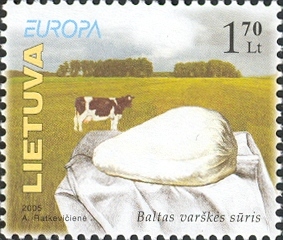
Other Names for Quark
In many languages, quark is also known as "white cheese." For example, in French, it's fromage blanc. In German, it can be Weißkäse. This name helps tell it apart from "yellow cheese," which is made with rennet.
In Austria, quark is often called Topfen. In Finland, it's rahka, and in Estonia, kohupiim. In Latvia, it's known as biezpiens, meaning "thick milk." These different names show how popular and widespread quark is across various cultures.
How Quark is Made
Quark is part of a group of cheeses called acid-set cheeses. This means the milk thickens mainly because of the acid produced by lactic acid bacteria. These bacteria eat the lactose (milk sugar) and create lactic acid.
Most quark is made using pasteurized skim milk. Cream can be added later to change how much fat the quark has. The lactic acid bacteria are added as a "starter culture." In large dairies today, a small amount of rennet is often added after the bacteria, when the milk is still only slightly acidic. The milk then continues to get more acidic until it reaches a certain pH level. At this point, the milk's casein proteins start to clump together, forming the curds.
In Germany, the quark is stirred constantly to keep it from getting too hard. This makes it thick and creamy. German quark is usually sold in plastic tubs. It has a texture similar to sour cream but is a bit drier and can be slightly crumbly.
Basic quark, often called Magerquark, has very little fat (about 0.2%). Quark with more fat is made by adding cream after it cools. This gives it a smooth, creamy texture and a slightly sweet taste. A firmer version, Schichtkäse, is sometimes used for baking.
To get the right thickness, some or most of the whey is removed. Traditionally, this was done by hanging the curds in a muslin bag or cheesecloth and letting the whey drip out. This often gave quark its unique wedge shape. In factories, machines called centrifuges separate the cheese from the whey.
The way quark is made can vary by region. Austrian and other Central and Eastern European types of quark often have less whey, making them drier and more solid than German or Scandinavian versions.
Tasty Ways to Use Quark
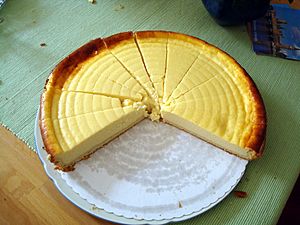
Quark is used in many different dishes, from appetizers and salads to main courses and desserts.
In Germany, quark is commonly sold in tubs with different fat levels:
- Magerquark: Skimmed quark, very low in fat.
- "Regular" quark: Has a moderate fat content.
- Sahnequark: Creamy quark, with added cream for a higher fat content.
Magerquark is often used for baking or eaten for breakfast with fruit or muesli. Sahnequark is the base for many quark desserts, which often come with fruit flavors or vanilla.
Dishes in Germanic Countries
One very popular use for quark is in making cheesecake. In Germany, it's called Käsekuchen or Quarkkuchen. In Austria, it's Topfenkuchen. These cheesecakes are often baked.
In the Netherlands, kwarktaart (quark cake) is popular. These cakes usually have a cookie crust and are mixed with whipped cream, gelatine, and sugar. They don't need baking; they just firm up in the refrigerator.
In Austria, Topfen is also used in desserts like Topfenstrudel (a pastry roll) and Topfen-Palatschinken (a type of crepe).
Quark is also used in savory dishes. In Germany, Kräuterquark is quark mixed with chopped onions and herbs like parsley and chives. This is often eaten with boiled potatoes. Quark with linseed oil and potatoes is a traditional dish in some parts of Germany.
Slavic and Baltic Countries
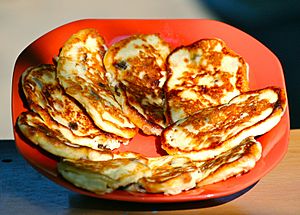
In Slavic countries, quark (called tvorog in Russian) is used in many desserts. These include cheesecakes like sernik in Poland and tvarožník in the Czech Republic. Sweet cheese pancakes called syrnyky are also very popular in Russia and Ukraine.
In Poland, twaróg is mixed with mashed potatoes to make a filling for pierogi (dumplings). It's also used for leniwe pierogi ("lazy pierogi"), which are gnocchi-shaped dumplings.
In Russia, Ukraine, and Belarus, tvorog is a very common food. It's often eaten simply with sour cream, jam, or sugar for breakfast. It's also used as a filling for blinchiki (thin pancakes). For Easter, tvorog is mixed with eggs, sugar, raisins, and nuts to make a pyramid-shaped dessert called paskha.
In Latvia, quark is eaten savory with sour cream and scallions on rye bread or with potatoes. For desserts, it's baked into biezpiena plātsmaize (a sheet cake) or made into biezpiena sieriņš (small sweetened quark blocks dipped in chocolate).
- Dishes including quark
-
Blintzes / naleśniki filled with quark and garnished with blackberries
-
Russian paskha
-
Saxon Quarkkäulchen served with hot sour cherries
-
Noodle kugel with quark and raisins
-
Pirog with quark and beet greens filling
Where to Find Quark in Other Countries
While quark is very common in Europe, it's less common to find it made in the Americas. However, some dairies do produce it. For example, Lifeway Foods makes a product called "farmer cheese" which is similar to quark. Some companies, like Elli Quark in California, offer soft quark in different flavors.
In Canada, you can find both the firmer East European style and the softer German-style quark. It might also be sold as baking cheese, pressed cottage cheese, or fromage frais.
In Australia, Ukrainian traditional quark is made by Blue Bay Cheese. It's also sometimes available in supermarkets labeled as quark or quarg.
In New Zealand, Karikaas makes European traditional Kwark.
In the United Kingdom, many supermarkets sell their own brands of fat-free quark, as well as other brands.
In Finland, quark (rahka) is widely available in supermarkets, both plain and flavored. It's often used as a dessert mixed with berries and whipped cream.
ba:Эремсек et:Kohupiim eo:Kazeo sl:Skuta (mlečni izdelek) tt:Eremçek
See also
 In Spanish: Queso quark para niños
In Spanish: Queso quark para niños


